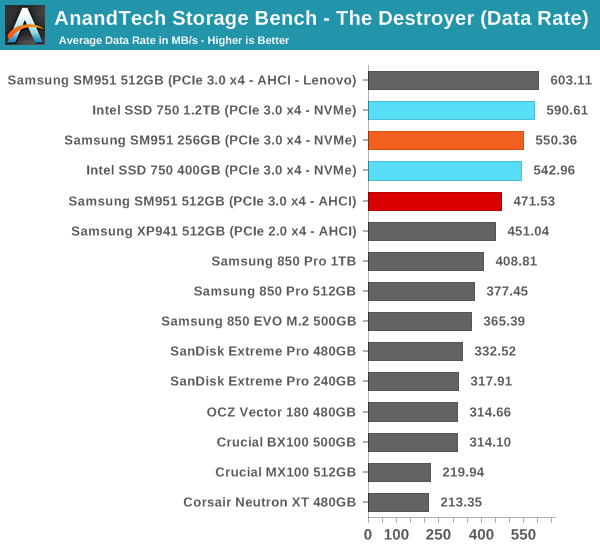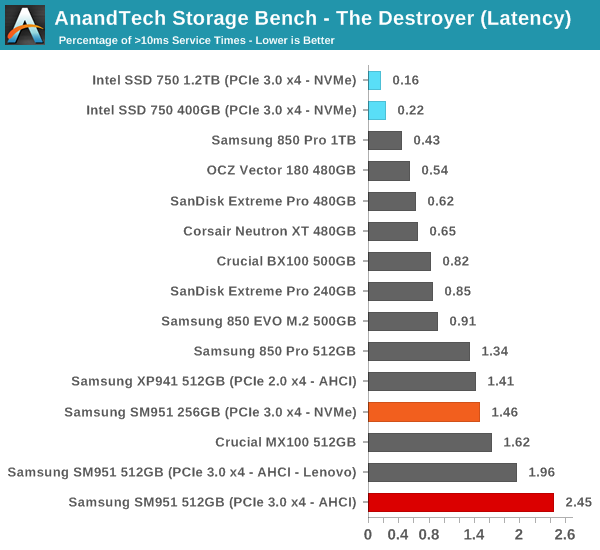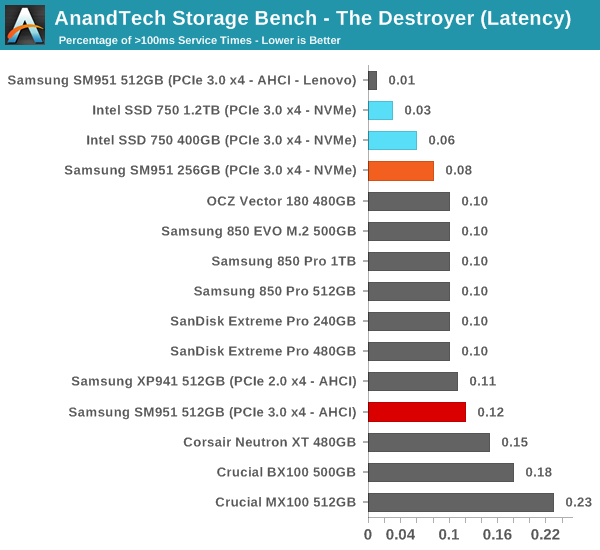Samsung SM951-NVMe (256GB) PCIe SSD Review
by Kristian Vättö on June 25, 2015 9:40 AM ESTAnandTech Storage Bench - The Destroyer
The Destroyer has been an essential part of our SSD test suite for nearly two years now. It was crafted to provide a benchmark for very IO intensive workloads, which is where you most often notice the difference between drives. It's not necessarily the most relevant test to an average user, but for anyone with a heavier IO workload The Destroyer should do a good job at characterizing performance. For full details of this test, please refer to this article.

In our The Destroyer trace, the SM951 NVMe is faster than the AHCI version despite having only half the NAND, but it still gets beaten by the SSD 750 (although the SSD 750 has more NAND as well). As I mentioned in the review, the SSD 750 has excellent small IO performance under intensive IO loads, resulting in much lower latency than what the SM951 offers, but since it performs more poorly with sequential IOs the average data rate is equivalent to the SM951 NVMe. What's surprising, though, is the fact that the SM951 AHCI that was pulled from the Lenovo laptop is in fact considerably faster than the stock SM951 we received straight from Samsung. I even ran the trace twice the ensure that it's not a benchmark anomaly, but maybe there is something wrong with my sample given that even the XP941 and several SATA 6Gbps drives outperform it.

The SM951 NVMe also has a higher share of high latency IOs than the SSD 750, but that's quite typical to smaller capacity Samsung drives.












74 Comments
View All Comments
bigbrainz - Wednesday, September 16, 2015 - link
So which would be best for video editing (not rendering--the editing/preview stage)? The 750 or the SM951 (AHCI since the NVMe isn't really available yet)? Generally that would mean playing back one video stream, although with compositing it can briefly get to 2 at a time. Rarely more than that though (for my videos). I'm not really sure if that would be considered random or sequential or light or heavy or what?THANKS!!!!
metaxis - Wednesday, October 28, 2015 - link
It's really unfortunate how much these performance line graphs squander the benchmark data you've gathered.* One device at time prevents visual comparisons.
* One graph from a series at a time means a ton of toggling back an forth, or opening a lot of windows
* ...but, because the scale isn't fixed, you *still* can't visually compare them.
The graphs are pretty terrible over at /bench too.
* no horizontal scale labels
* product/comparison mixes "less is better" and "more is better" with abandon
* you have to hunt around a ton to actually get anything useful
* choose *either* 2 devices and all the shared benchmarks *or* all devices that happen to have been tested under a single benchmark
* links to product reviews mostly gone
These are some of the weakest visualizations of this valuable set of data I can imagine, and it makes me sad.
dtscaps - Friday, March 11, 2016 - link
Ok, this is supposed to be a review to guide me what SSD to buy. I read 10 pages of performance specs and 72 more comments dealing with microseconds marginality. The fact that this drive does or does not have an AES self encrypting mechanism adering to OPAL 2 with a possible IEEE1667 extension IS IMPORTANT. IT IS A COMPLETE SHOW STOPPER if the drive cannot encrypt data. Maybe except if you are a kid playing with new toys.So, is this SSD self encrypting ?
Does it support Opal 2
Does it support the IEEE1667 extension?
Chris023 - Monday, April 25, 2016 - link
Just a little FYI for anyone that runs across this article. I just purchased the Samsung 950 pro boxed consumer version in 512GB. I Installed it with an adapter card in an old Asus M4a88TD-V EVO/USB3 motherboard. To my amazement the bios recognized and even put it in the boot sequence. I already had an 830 SSD. I booted up with the old SSD 830 and initialized this new 950. Then using Samsung's transfer software cloned the 830 to the 950. Rebooted, turned the 830 to disabled in the boot order, and enabled the 950 as the boot drive. It took two tries for me to realize I had to disable the 830 in the boot menu as the bios automatically looked for a bootable AHCI drive first. I have now been booting and running the 950 Pro for over a week with no issues. This is on an old AMD 880 chipset!!! This is a PCIe 2.0 MB! Even so it still manages to outperform the older Samsung 830 SSD enough to notice. User Bench shows my SSD performance going from 70% to 169% of average. Average will shoot up much higher once I get a true PCIe MB with native NVMe drive support.